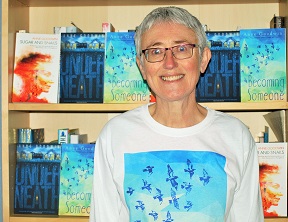How Romance Almost Hijacked My Heroine’s Journey And My Novel’s USP

When I worked as a therapist, I met many people with an upside-down notion of love. They were looking for someone to rescue them from a sense of being unlovable. What they needed was to learn to love themselves.
In publishing my debut novel, I almost made the same mistake for my character. Invited to submit an initial draft of the blurb for the back of the book, I sent my publisher this:
Diana has built her adult life around the need to keep her past identity a secret. At forty-five, she’s reasonably content, with her own house, a decent job, a loyal friend and her marmalade cat. Until Simon arrives on the scene. It’s twenty years since Diana last let a man into her life, and she’s still got the scars to show for it.
But Simon is different. Simon makes her feel she can live the dreams she’s always been denied. Except that Simon’s work is taking him to Cairo, and he expects Di to come out and visit him there. For her, the trip seems impossible, but it’s equally impossible to explain to Simon the reasons why. Whatever she does, she fears she’s going to lose him, and not only him, but the person she’s become. Unless she can find a way to reconcile herself with the teenager who went to Cairo, with the part of her she’s been at such pains to deny.
Over several emails, we agreed on a final format. But when I showed it off to friends in my book group, they expressed surprise I’d written a romance.
I hadn’t. I’d written a novel about a woman who needs to learn self-acceptance before she can let others get near. My first stab at a blurb wasn’t inaccurate, but, by emphasising the wrong angle, it misrepresented my novel. Diana’s problem isn’t her relationship with Simon, it’s her attitude to herself.
The published blurb isn’t dramatically different from my first attempt. It still mentions Simon, but Cairo has upstaged him:
 At fifteen, she made a life-changing decision. Thirty years on, it’s time to make another.
At fifteen, she made a life-changing decision. Thirty years on, it’s time to make another.
When Diana escaped her misfit childhood, she thought she’d chosen the easier path. But the past lingers on, etched beneath her skin, and life won’t be worth living if her secret gets out.
As an adult, she’s kept other people at a distance… until Simon sweeps in on a cloud of promise and possibility. But his work is taking him to Cairo, the city that transformed her life. She’ll lose Simon if she doesn’t join him. She’ll lose herself if she does.
Sugar and Snails charts Diana’s unusual journey, revealing the scars from her fight to be true to herself. A triumphant mid-life coming-of-age story about bridging the gap between who we are and who we feel we ought to be.
Why was I seduced into framing it as romance? I think it comes down to how humans are made.
We develop our blueprint for relationships in our earliest months of life, learning about love via our interactions with our primary carers. As adults, we unconsciously strive to recreate the conditions of love and acceptance we experienced from the beginning. Or, if our early years were emotionally disadvantaged, we yearn for the perfect love we missed. The desire for intimacy is ubiquitous. It’s as if we’re hard-wired for romance.
Which is wonderful for romance writers, but novelists in other genres need to soft-pedal. Don’t let romance hijack your heroine’s journey and your novel’s USP.
—
Anne Goodwin is the author of two novels and short story collection. Her debut novel, Sugar and Snails, was published by Inspired Quill in 2015 and shortlisted for the Polari First Book Prize. You can read it for free during February 2021 by registering for her newsletter here:
https://www.subscribepage.com/sugar-and-snails-free-e-book
Category: How To and Tips
























